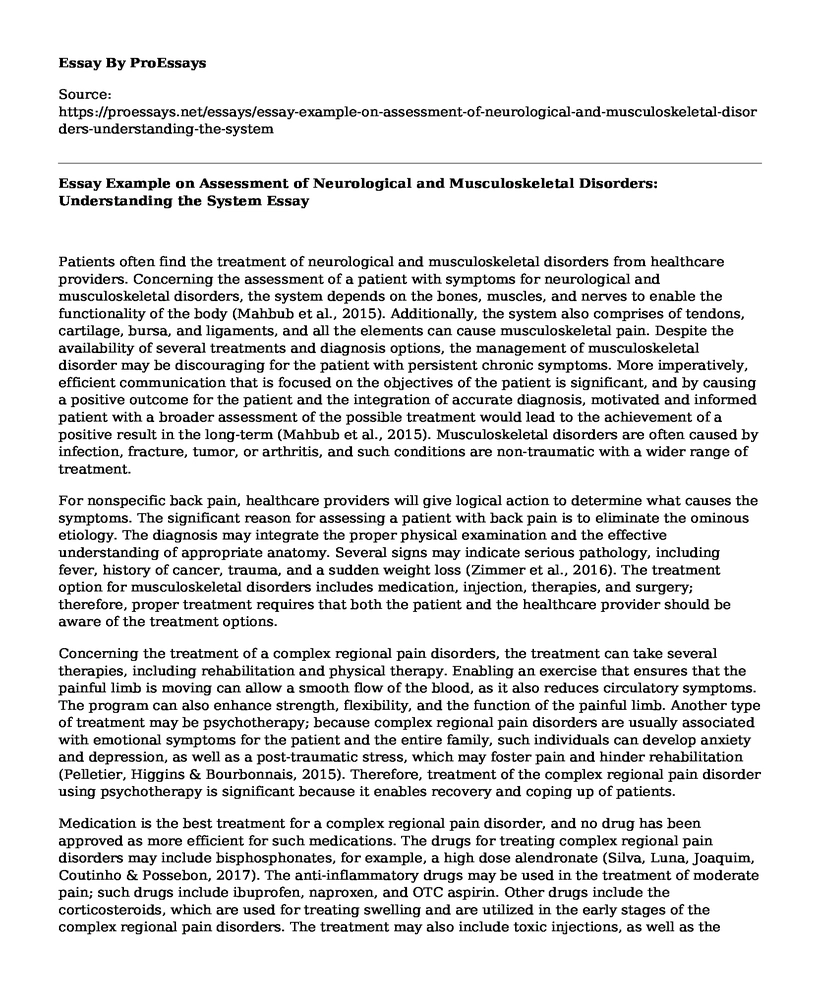Patients often find the treatment of neurological and musculoskeletal disorders from healthcare providers. Concerning the assessment of a patient with symptoms for neurological and musculoskeletal disorders, the system depends on the bones, muscles, and nerves to enable the functionality of the body (Mahbub et al., 2015). Additionally, the system also comprises of tendons, cartilage, bursa, and ligaments, and all the elements can cause musculoskeletal pain. Despite the availability of several treatments and diagnosis options, the management of musculoskeletal disorder may be discouraging for the patient with persistent chronic symptoms. More imperatively, efficient communication that is focused on the objectives of the patient is significant, and by causing a positive outcome for the patient and the integration of accurate diagnosis, motivated and informed patient with a broader assessment of the possible treatment would lead to the achievement of a positive result in the long-term (Mahbub et al., 2015). Musculoskeletal disorders are often caused by infection, fracture, tumor, or arthritis, and such conditions are non-traumatic with a wider range of treatment.
For nonspecific back pain, healthcare providers will give logical action to determine what causes the symptoms. The significant reason for assessing a patient with back pain is to eliminate the ominous etiology. The diagnosis may integrate the proper physical examination and the effective understanding of appropriate anatomy. Several signs may indicate serious pathology, including fever, history of cancer, trauma, and a sudden weight loss (Zimmer et al., 2016). The treatment option for musculoskeletal disorders includes medication, injection, therapies, and surgery; therefore, proper treatment requires that both the patient and the healthcare provider should be aware of the treatment options.
Concerning the treatment of a complex regional pain disorders, the treatment can take several therapies, including rehabilitation and physical therapy. Enabling an exercise that ensures that the painful limb is moving can allow a smooth flow of the blood, as it also reduces circulatory symptoms. The program can also enhance strength, flexibility, and the function of the painful limb. Another type of treatment may be psychotherapy; because complex regional pain disorders are usually associated with emotional symptoms for the patient and the entire family, such individuals can develop anxiety and depression, as well as a post-traumatic stress, which may foster pain and hinder rehabilitation (Pelletier, Higgins & Bourbonnais, 2015). Therefore, treatment of the complex regional pain disorder using psychotherapy is significant because it enables recovery and coping up of patients.
Medication is the best treatment for a complex regional pain disorder, and no drug has been approved as more efficient for such medications. The drugs for treating complex regional pain disorders may include bisphosphonates, for example, a high dose alendronate (Silva, Luna, Joaquim, Coutinho & Possebon, 2017). The anti-inflammatory drugs may be used in the treatment of moderate pain; such drugs include ibuprofen, naproxen, and OTC aspirin. Other drugs include the corticosteroids, which are used for treating swelling and are utilized in the early stages of the complex regional pain disorders. The treatment may also include toxic injections, as well as the anesthetic creams, including lidocaine (Silva et al., 2017). It is worth noting that such drugs may cause different side effects, including dizziness, drowsiness, impaired memory, and increased heartbeat, and it is important to visit the hospital more frequently and inform the healthcare provider of any change experienced during the execution of drug therapy. Other treatment methods include a sympathetic nerve block that involves the injection of the anesthetic, which avert the sympathetic nerve activity and enhance the flow of blood.
References
Mahbub, M. H., Kurozawa, Y., Ishitake, T., Kume, Y., Miyashita, K., Sakakibara, H., ... & Harada, N. (2015). A systematic review of diagnostic performance of quantitative tests to assess musculoskeletal disorders in hand-arm vibration syndrome. Industrial health, 53(5), 391-397.
Pelletier, R., Higgins, J., & Bourbonnais, D. (2015). Addressing neuroplastic changes in distributed areas of the nervous system associated with chronic musculoskeletal disorders. Physical therapy, 95(11), 1582-1591.
Silva, N. E., Luna, S. P., Joaquim, J. G., Coutinho, H. D., & Possebon, F. S. (2017). Effect of acupuncture on pain and quality of life in canine neurological and musculoskeletal diseases. The Canadian Veterinary Journal, 58(9), 941.
Zimmer, L., Goldinger, S. M., Hofmann, L., Loquai, C., Ugurel, S., Thomas, I., ... & Hassel, J. C. (2016). Neurological, respiratory, musculoskeletal, cardiac and ocular side-effects of anti-PD-1 therapy. European journal of cancer, 60, 210-225.
Cite this page
Essay Example on Assessment of Neurological and Musculoskeletal Disorders: Understanding the System. (2023, Mar 26). Retrieved from https://proessays.net/essays/essay-example-on-assessment-of-neurological-and-musculoskeletal-disorders-understanding-the-system
If you are the original author of this essay and no longer wish to have it published on the ProEssays website, please click below to request its removal:
- Adherence to WHO Breastfeeding Guidelines Among HIV Positive Mothers in African Countries
- Research Paper on Population Health Policy Analysis
- Essay Sample on Pancreas and Diabetes: Progenitor Cells & Insulin Secretion
- Essay Example on Telehealth Revolution: Better Care Through Data Systems
- Essay Example on Robotic Companions: The Future of Human Life?
- Essay Sample on Health Considerations in Canada's Foreign Policy: Impact of Globalization
- Free Paper Sample on Caries Risk and Primary Dentition in Children







